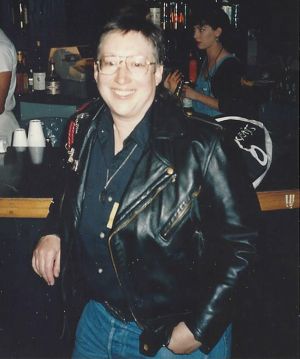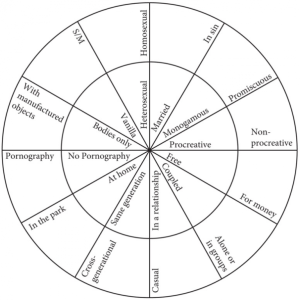One of our staff members is contributing considerably to a News Archiving service at Mu. Any well educated (Masters, PhD or above) users who wish to make comments on news sites, please contact Jim Burton directly rather than using this list, and we can work on maximising view count.
Gayle Rubin: Difference between revisions
No edit summary |
|||
| Line 26: | Line 26: | ||
*[[Michel Foucault]] | *[[Michel Foucault]] | ||
*[[Judith Butler]] | *[[Judith Butler]] | ||
*[[ | *[[Patrick Califia]] | ||
</div> | </div> | ||
Revision as of 02:27, 21 March 2023

Gayle S. Rubin (born January 1, 1949 in South Carolina) is an American cultural anthropologist best known as an activist and theorist of sex and gender politics, often referred to (and scapegoated as) a founder of Queer Theory. She has written on a range of subjects including feminism, sadomasochism, prostitution, pedophilia, pornography and lesbian literature, as well as anthropological studies and histories of sexual subcultures, especially focused in urban contexts. Her 1984 essay "Thinking Sex" is widely regarded as a founding text of gay and lesbian studies, sexuality studies, and queer theory. She is an associate professor of anthropology and women's studies at the University of Michigan.
"Thinking Sex"
In her 1984 essay "Thinking Sex", Rubin interrogated the value system that social groups—whether left or right-wing, feminist or patriarchal—attribute to sexuality which defines some behaviors as good/natural and others (such as pedophilia) as bad/unnatural. In this essay she introduced the idea of the "Charmed Circle" of sexuality, that sexuality that was privileged by society was inside of it, while all other sexually was outside of, and in opposition to it. The binaries of this "charmed circle" include couple/alone or in groups, monogamous/promiscuous, same generation/cross-generational, and bodies only/with manufactured objects. The "Charmed Circle" speaks to the idea that there is a hierarchical valuation of sex acts. In this essay, Rubin also discusses a number of ideological formations that permeate sexual views. The most important is sex negativity, in which Western cultures consider sex to be a dangerous, destructive force. If marriage, reproduction, or love are not involved, almost all sexual behavior is considered bad. Related to sex negativity is the fallacy of the misplaced scale. Rubin explains how sex acts are troubled by an excess of significance.[1]
The "Charmed Circle"

Rubin's famous theory of the "Charmed Circle" has been used by historian Rachel Hope Cleves in her study of the Victorian historical MAP / pederast figure Norman Douglas, to explain why age-disparate sex was common and normal compared to post-1980 attitudes.[2] In addition to noting how, "During the late 1980s and 1990s, the figure of the monstrous pedophile [... replaced] the earlier ambivalent figure of the pederast [... becoming] the subject of sex crime panics on both sides of the Atlantic" (2020, p. 278), Cleves wrote:
Writing in the midst of a surging moral panic during the early 1980s, Rubin predicted that in twenty years the smoke would clear and pedophiles would be recognized as “victims of a savage and undeserved witch hunt.” [...] Rubin’s prediction has proven [...] wrong [...]. The taboos against sex between adults and young people have become more strenuous with each passing year, to the point that many people now profess revulsion at cross-generational encounters involving young adults and older adults, which seldom raised moral hackles in the past. (p. 13).
Rubin's charmed circle illustrates how different sexual practices exist on the outer limits of social acceptability, with those practices and desires in the center of the circle being regarded as "normal" / the norm in a given culture. Her diagram relates to the history of sex in the West, especially after the 1945 post-war period and the conservative backlash era of the 1980s. On the charmed circle, Cleves wrote:
By studying Douglas’s life, we can illuminate a world where the “charmed circle” of sexuality, as theorist Gayle Rubin puts it, was so narrow that those who were cast outside its limits shared common ground. Identity categories that are distant from each other today — like loose women, lesbians, and pederasts — were more proximate when they were all outside the charmed circle. Pederasty was less taboo before the 1950s, in effect, because so many other behaviors were disreputable as well. Pederasty was less distinct from other types of sexual non-conformity. (Ibid).
External Links
- VIDEO: LGBT Queer Pioneer Gayle Rubin on Qanon and Child Porn (2022)
- Wikipedia - Full article.
- Ipce
See also
References
- ↑ Thinking Sex - The full article.
- ↑ Rachel Hope Cleves, Unspeakable: A Life Beyond Sexual Morality (Chicago: University of Chicago Press, 2020).